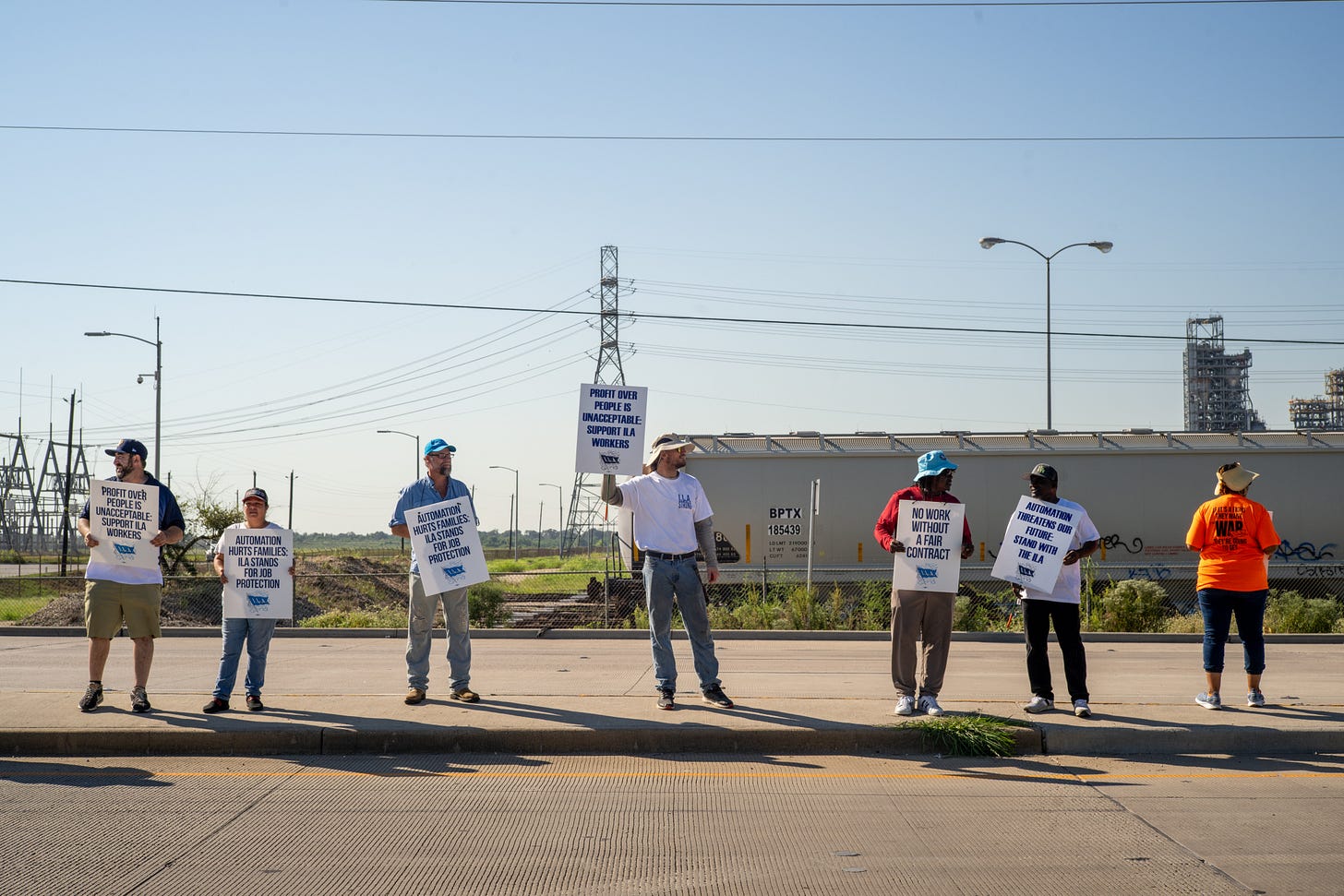The Longshoremen Are Making the Wrong Demands
They shouldn’t be trying to block automation. They should be trying to adapt to it.
THE INTERNATIONAL LONGSHOREMEN’S ASSOCIATION ended a three-day strike last Thursday after reaching a deal with a consortium of port operators for a large wage increase for the the 47,000 dockworkers, phased in over the next few years. The deal gives both sides until mid-January to settle the remaining questions—including how and whether the dockworker jobs may be automated. Longshoreman union president Harold Daggett has demanded “absolute airtight language that there will be no automation or semiautomation.”
Such a ban on automation is not going to, and should not, happen. The longshoremen, nonetheless, have a point. Containerization radically reduced demand for unskilled and semi-skilled port workers and hyper-automation will further reshape skill requirements and, in the short-term, eliminate some jobs. It is painful to be on the destruction end of creative destruction. As these workers deal with a future beyond their (or anyone else’s) control, they deserve our sympathy and tangible support.
We have some recent experience with what happens when a small segment of the labor force bears the costs of automation while the rest of the country reaps the benefits. From the late 1990s into the early 2000s, manufacturing workers were hit hard by automation and, to a lesser degree, by more open international trade. The United States lost an estimated 5.8 million manufacturing jobs, with up to 90 percent of these losses attributed to automation. Factories either automated or, in search of cheaper labor, relocated within the United States or overseas. Policymakers, focused on the real overall gains for the economy, gave little thought to the millions who would need retraining, and even less to the transition support the federal government might provide. As a result, these layoffs triggered a political and cultural backlash, the effects of which continue to reverberate.
The longshoremen are justifiably worried that the fate of Rust Belt factory workers, elevator operators, and stagecoach drivers awaits them. But their union, by seeking to prevent near-term job losses through a ban on automation, is demanding the wrong thing. Change, in the form of automation, is inevitable if the American economy is to remain competitive. The main question the union leaders, government policymakers, and the public should be asking is not how to stop automation—at the docks or anywhere else—but how we should help workers adapt when technology threatens their livelihoods. Artificial intelligence, which will likely bring increased automation to the professions and middle management, means most American workers have skin in this game.
The federal Trade Adjustment Assistance (TAA) program is probably a good place to start. TAA, which Congress and the Biden administration inexplicably allowed to lapse in 2022, was established under the Kennedy administration to help retrain trade-impacted workers. The program provides a wide range of benefits including training, job search and relocation allowances, a health coverage tax credit, income support, and other reemployment services. The program’s short-term outcomes are comparatively modest but its long-term effects on workers in terms of reskilling and wages have been significant. A TAA-like program for automation-impacted workers makes sense to cushion the immediate effects that AI and robotics are likely to have in a wide range of sectors, jobs, and skills.
One of the key challenges in the TAA program was sluggish management. Trade impacts were cumbersome to certify and, therefore, relatively rare. An automation adjustment assistance program would need a more agile, redesigned certification system. Since such a program would include extended unemployment for workers engaged in retraining, effective triaging of workers would be vital to ensure that those with in-demand skills can move as quickly as possible into new jobs rather than languishing on public benefits. Alternatively, the country could move to a voucher-based system, allowing automation-impacted workers to make their own decisions about retraining, relocation, or, for older workers, as a bridge to retirement.
Our ports are grossly inefficient compared to competitor nations, especially China. The benefits of automation—for efficiency and economic growth—will vastly outweigh any short-term benefits the longshoremen’s proposed ban would confer on its union members. Further, these efficiencies are likely to drive so much more import-export business that the total dockworker/longshoreman workforce could end up expanding.
The automation ban would make us less competitive and dynamic, and tax the majority of Americans to benefit a small but powerful sliver of the workforce. King Canute couldn’t hold back the tide, and the longshoremen shouldn’t try, either.




